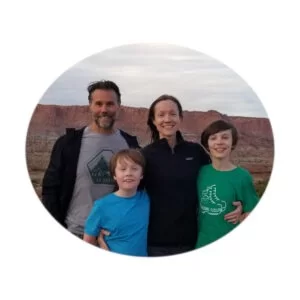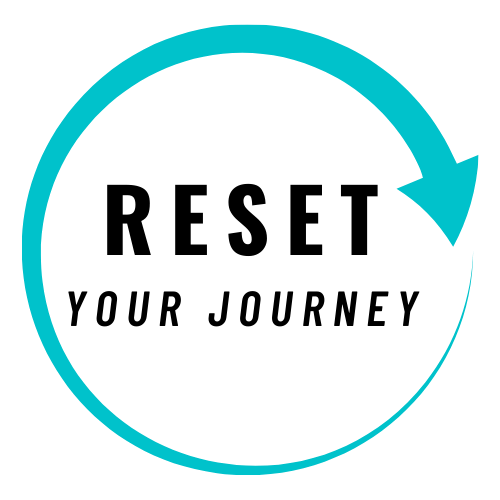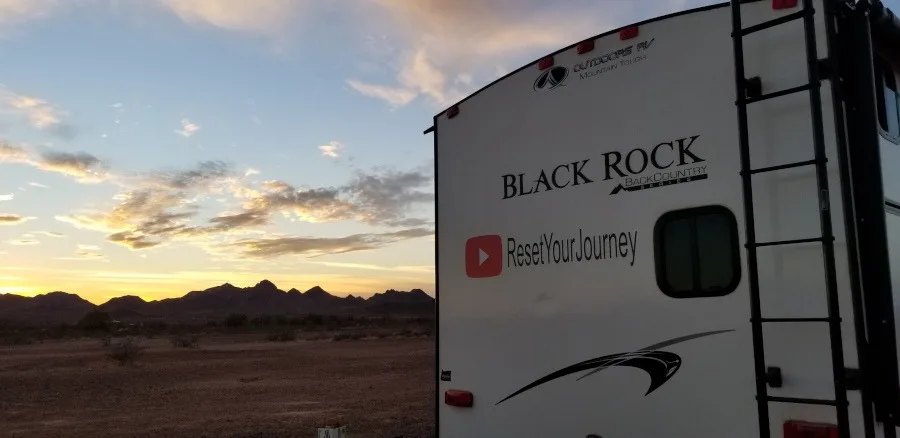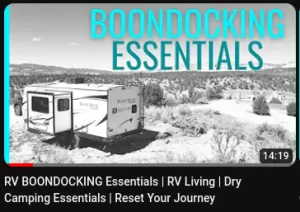Last Updated on 07/20/2024 by Glynn Willard
Is Boondocking In Remote Locations A Good Idea?
From a distance, I could see him working with several long-blade knives and a pistol.
This is when I questioned the safety of boondocking in remote areas.
I never even considered whether dispersed camping is safe or not. But I was about to be tested.
I knew I had three options to keep my family safe in the middle of nowhere.
I could leave, I could completely ignore him and keep my distance or I could try to establish friendly communication.
I chose the latter.
Don’t feel like reading? Listen to the audio version of this blog read by Glynn.
Is Boondocking Safe?
Before we discuss any safety concerns for boondocking, let me just say that we always feel safer boondocking than we do in any campground.
The only exception to the rule was The Palms RV Resort. In no way, shape, or form did it feel unsafe. But that’s the only campground where I felt like I could leave all our possessions unlocked.
When we disperse camp on either Bureau of Land Management (BLM land) or National Forests, we go where there are very few people.
Regardless, when you’re camping on public lands, you should always know your surroundings, be vigilant, have an exit strategy, and get to know those camping around you.
I say this because that’s how we function regarding all circumstances, not just wild camping.
Let’s go into more detail.
Boondocking Safety Tips
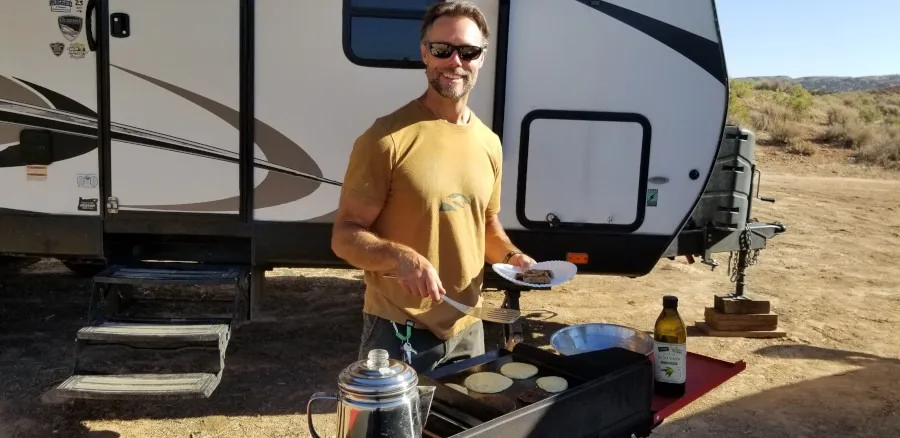
Breakfast while safely boondocking. Good times!
Follow these tips for safe boondocking, peace of mind, and your own safety.
- Read reviews on boondocking social media sites and apps to get an idea of whether it’s safe to boondock there.
- Contact the closest ranger station to ask about recent crime in the area where you’re staying. It’s a great way to get an honest answer.
- Learn about the local wildlife (bears, snakes, spiders, etc.) The old adage “know before you go” could save you or your pet’s life.
- Keep bear spray on hand. It’s a great defense weapon against bears, other wildlife, or threatening people.
- When you arrive at a new dispersed camping location, send a loved one your exact coordinates and how long you plan to stay.
- Learn the location of the closest emergency medical services. You don’t want to be searching during an emergency.
- Remember, if you feel unsafe boondocking in your current location, you can always leave and find free campsites elsewhere.
- Bottom line: Trust your gut!
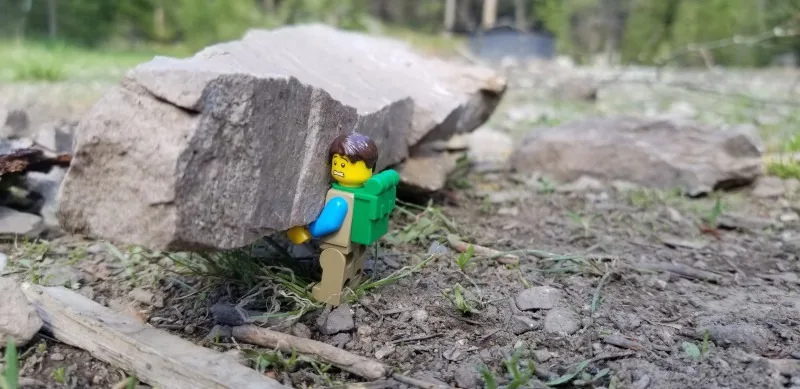
Learn the location of the closest medical emergency services before boondocking accidents happen.
Our First Scary Experience Boondocking [Suspicious Character]
[A continuation of the intro story…]
My first attempt to say hello was only partially successful.
I gave the “tough guy” head nod/wave and received a nod in return.
That was enough to ease my tension temporarily, but I was still uncomfortable letting the boys play outside.
That said, I felt the same way about keeping Rose out of his view.
All of this makes for an uncomfortable situation and we had the option to leave.
But this particular area had very little dispersed camping or overnight parking available. Trust me, we started preparing an exit strategy just in case.
Then I noticed something. He had a small dog and a cat at his campsite. I watched him pour the last of a Gerry can of water into the pet’s bowl.
Then he attempted to drink the last drops from the can. At least he was compassionate toward animals.
I saw this as an opportunity. I approached his sight and before even saying hello, I asked, “How are you on water?”
He immediately let his guard down and stated he had just used up his last bottle and wasn’t leaving until the next day.
It would have taken him half a day to break down his camp and potable water sources or a dump station was not close by.
I had over a hundred gallons in my freshwater tank and would be refilling again in three days.
Before I could say anything else to him, he said “You wouldn’t by chance be able to spare a gallon of water?”
I gladly obliged. I gave him enough water to get through the next day without him or his pets being thirsty.
He was genuinely thankful and proceeded to tell me how much he despised the government, society, and people in general.
He also took the time to show me his gun collection. I was able to speak that particular language implying that we’re a family not to be messed with.
By the end, he was praising me for raising my kids outside of “the norm” and teaching them to live off-grid.
He never gave us any trouble and even made the effort to say goodbye and thank me again when he rolled out the next day.
You may be reading this and thinking that we overreacted, but being vigilant is one of the keys to remaining safe while boondocking.
Are Campgrounds Safer Than Boondocking?
Short answer, no. Except for the resort I mentioned earlier, I always felt the need to secure everything in and around the rig in RV parks.
This is because so many people are around the campsite. Statistically speaking, an increase in that variable increases the probability of theft or dispute.
Most state parks and the Army Corps of Engineers felt safe with a few exceptions.
It was always the campgrounds that mixed the long term renters with short term renters that gave us discomfort.
We only use such campgrounds when going a long distance between destinations.
We prefer those options over truck stops, rest areas, a Cracker Barrel, a Walmart parking lot or other big box stores.
On a side note, Harvest Hosts and Boondockers Welcome are great for overnight parking on private land.
My guard is up and my head is always on a swivel in campgrounds. This is not the case when we’re boondocking most of the time.
So, ultimately, I believe dispersed off-grid camping is safer than paid campgrounds.
Our Second Scary Experience Dispersed Camping [Scary Weather Conditions]
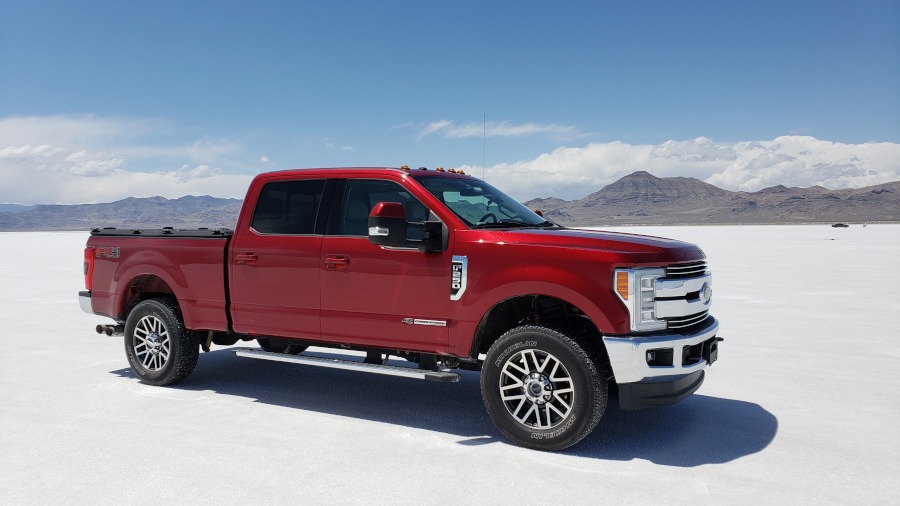
Our F250 on the Salt Flats in Utah.
On this particular occasion, we were just off the Salt Flats in Utah. There was no one around us, the site was accessible and we had a clear view in all directions.
As we were preparing for bed, it began to rain. No big deal, right?
And then the winds began to pick up, A LOT!
The ground winds coming down the leeward side of the mountain were so intense, the trailer felt like it was going to tip over!
This was before I learned to check the wind direction before aligning the trailer and facing the front into the wind.
I kept Googling the amount of wind force necessary to tip a trailer. According to several manufacturer’s stats, we were safe.
But it sure didn’t feel that way!
On another occasion in Mississippi (we were in a state park), bad weather was approaching that was dropping tornadoes left and right.
We chose to rent a hotel room thirty miles south where less severe weather was predicted. It was a good call.
That particular storm dropped a tornado one mile north of our campsite. Scary!
The last weather-based unsafe boondocking circumstance was in Vernal, UT.
The mud was so bad at our dispersed camping site that we almost slid our truck directly into the side of our travel trailer after returning from a trip into town.
Lesson learned! Make a mental note of this point, so you’re prepared for slippery mud.
The dangers of boondocking are not always suspicious characters, but sometimes a dangerous weather forecast.
Harassment By Law Enforcement When Boondocking
I’ve heard people talk about this subject as well as read about being harassed by rangers.
Even in the middle of the night!
We’ve only experienced helpfulness and kindness from law enforcement on BLM land or National Forests.
Knowing the local laws in advance helps. Also, when you encounter law enforcement, seeking their advice is the best way to establish a solid rapport.
Show them respect and be kind and you’ll likely get the same in return.
If you’re camped in an off-limits area and you’re told to leave, do so willingly and ask for advice as to where to go.
You might just learn a great new boondocking location that’s safe and a great option for your next camping trip.
Should You Carry Guns When Boondocking?
This is a matter of personal opinion.
If you decide to carry, make sure you know the gun laws for each state in which you are camping.
A simple Google search will send you down a rabbit hole of endless information. Study what applies to you.
Obtaining specialized training and a concealed carry permit can help keep you out of sticky legal situations.
We do carry because we like to target shoot where it’s allowed on BLM land.
Side note, if you shoot on public lands during your off-grid adventures, please pick up your brass!
Our Third Scary Experience Dispersed Camping [Roads]
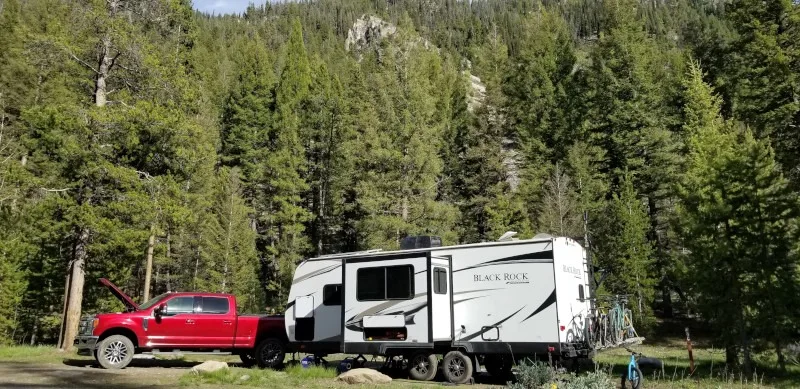
Scary roads revealed one of our favorite boondocking locations in Idaho.
Sometimes, the roads into a dispersed camping area that’s off the beaten path are what’s unsafe for boondocking.
On more than one occasion, we traveled some very scary single lane dirt roads with a high elevation drop off the edge.
We were fortunate not to encounter any oncoming traffic.
We couldn’t back up or pull off, so I don’t know how we would have solved that problem.
On one particular occasion in Idaho, we were heading down an old dirt road lined with dispersed camping sites.
They were all occupied, so we kept going. The road was tree-lined, so I couldn’t tell from the satellite image if there was a turnaround.
We got to the end and guess what!
No turnaround!
Rather than back out, we decided to try a “three-point turn.”
That turned into a sixty-two thousand point turn, completely jack-knifing the trailer over and over. Not fun!
Fortunately, Rose and a few fellow campers helped guide my turn.
Sometimes, the unsafe aspect of dispersed camping is the roads!
Is Free Camping In National Forests Safe?
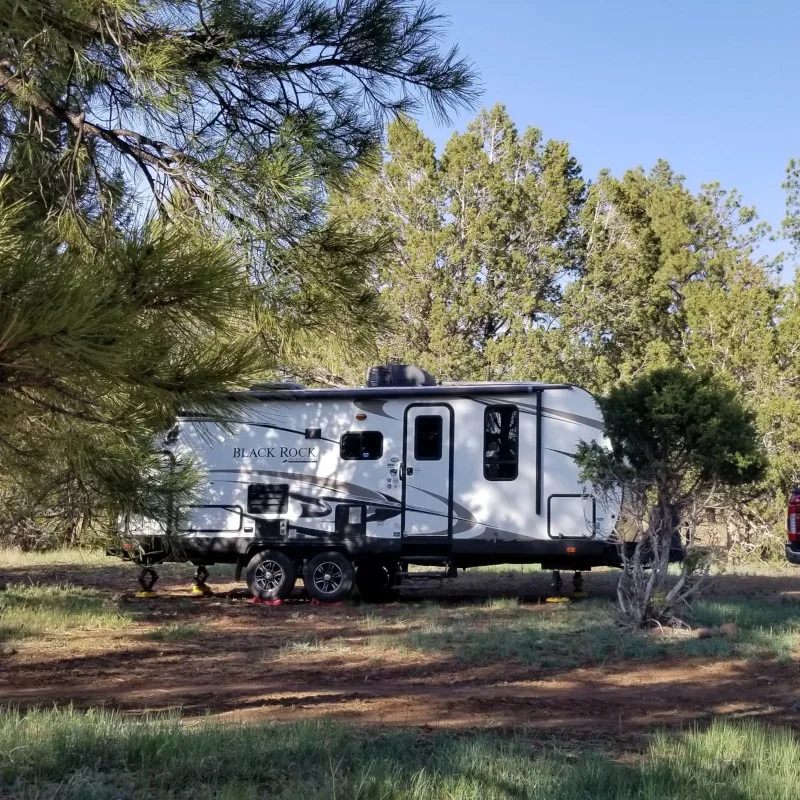
Safe dispersed camping location outside of Flagstaff, AZ.
We spent about thirty percent of our time in National Forests in the West during our two full-time years of serious boondocking.
We rarely felt unsafe and found the roads to be very well maintained.
In fact, there’s a stronger ranger presence in National Forests than on BLM land adding to the sense of security.
As long as you incorporate the tips listed above, free camping in National Forests is safe.
Is Free Camping On BLM Land Safe?
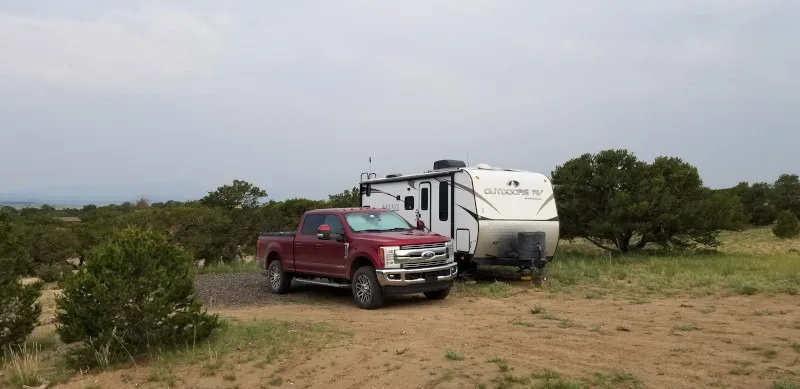
Safe free dispersed camping near Durango, CO on BLM land.
We spent about sixty percent of our time on BLM land.
And we’ve stayed in some shady areas without any issues.
Regardless of whether we stay in popular areas or not, we always find BLM land to be vast, safe, and loaded with safe dispersed camping spots.
It’s large enough that you can go off on your own to find dry camping spots and be almost hidden.
Again, if you incorporate the tips listed above, free dispersed camping on BLM land is safe.
Is It Safe To Boondock With Pets?
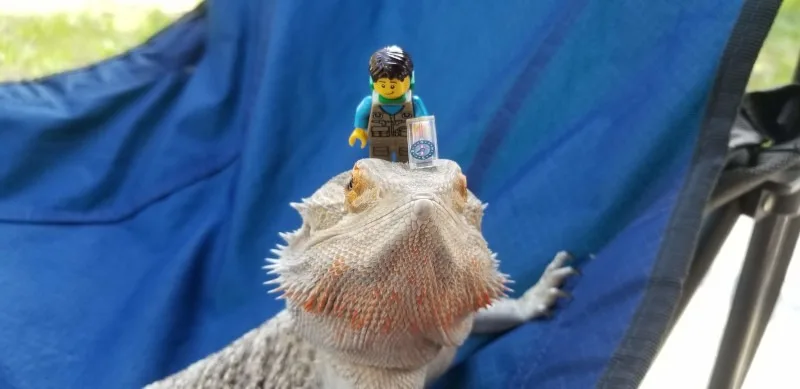
Our boondocking beardie!
Safe boondocking with pets starts with knowing the surrounding terrain and wildlife before selecting a location for a dispersed camp.
On one side, having a dog with you creates an early warning system. But small dogs can also fall prey to certain wildlife.
Until our bearded dragon, Max passed away, we had to always watch the sky for birds of prey when he was outside sunning himself.
Again, be smart and vigilant, and boondocking with pets can be very rewarding. Ignore potentially risky wildlife and you may lose your pets.
Bear Attacks When Boondocking?
If you live in bear territory, you’ve likely been raised with the knowledge required to minimize the risk of a bear attack.
But this section doesn’t just pertain to grizzly bears or black bears.
Many wild animals can be dangerous when dispersed camping (moose, alligators, wolf, etc.).
We’ve experienced the presence of a bear nearby, but nothing up close and personal.
Keep your campsite clean and free of outside food and you’ve done the most you can to avoid attracting dangerous wildlife.
Always keep a close eye on the ground for snakes. Rattlesnakes (we see a lot) can be underfoot without your realization if you’re not paying attention.
We see rattlesnakes on hikes and even around the rig. If you leave them alone, they’ll leave you alone. Remember, we’re not on their menu.
Our Fourth Scary Experience Dispersed Camping
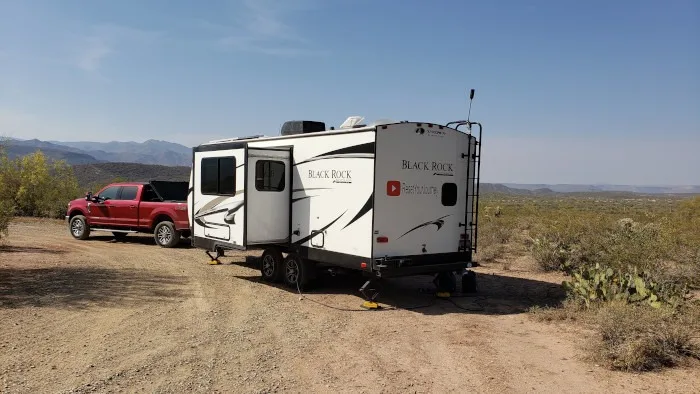
The boondocking location outside Phoenix with the most rattlesnakes.
Maybe this isn’t scary to some, but since we’re from the East, it was unsettling to us.
This potentially unsafe boondocking event occurred just north of Phoenix for a week before heading to Sedona.
I went out in the evening and saw what looked like several baby snakes under the travel trailer.
With closer investigation, they were rattlesnakes! So where was mama snake?
I used a long stick to carry them away and warned the family to look under the steps before putting their foot down on the ground.
I never did find the “momma snake.”
But as a parent, one can’t help but think about their young child stepping on and getting bit by a rattlesnake (under the circumstances).
Again, this just goes back to being hyper-aware of your surroundings when boondocking.
Social Media And Boondocking
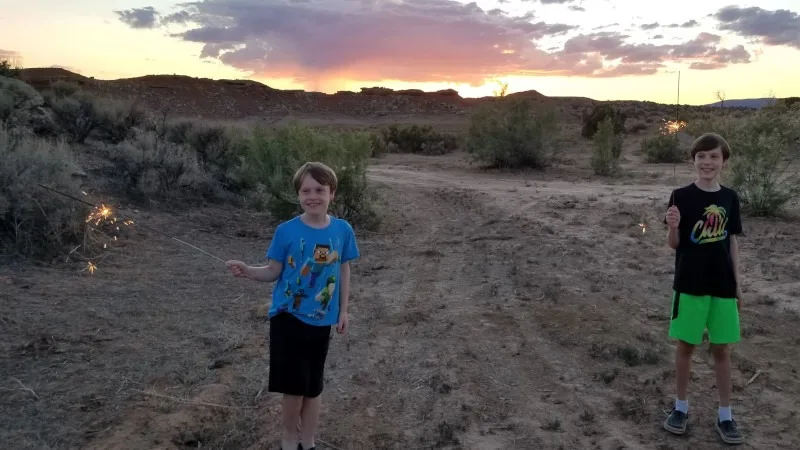
A safe dispersed camping spot near Vernal, UT.
Modern times attribute to new dangers of boondocking.
Perhaps one of the most dangerous things you can do is post your current location if you have a lot of followers.
Especially if those followers are strangers.
We never post our current location on anything. In fact, all posts are either days or weeks behind.
It’s just good practice and safer that way.
So, before posting, keep in mind who may be making note of your location.
There are other ways to send your coordinates to your friends.
Is Boondocking More Dangerous With So Many Fulltime Boondockers?
This is something I have thought about frequently.
I suppose statistically, it makes more sense that criminal activity will increase with more subjects.
I think the real danger is to the land. More trash, abuse, and crowding is the most logical outcome.
Regardless of whether your boondocking location is sparse or overpopulated, you still need to remain vigilant.
Not Sure What You Need For Your RV?
Safety Of Water Source When Dispersed Camping
This is a legitimate safety concern when boondocking. If you happen to fill your fresh water tank with contaminated water, it can get ugly quickly.
Finding safe drinking water before dispersed camping is crucial.
You can learn more about finding safe water in our article How Much Water Do You Need While Boondocking?
Imagine everyone in the camper sick, you’re water’s unsafe and you can’t move because you’re too sick.
This could ultimately spell disaster.
I assure you, we know firsthand!
Our Fifth Scary Experience Boondocking
We were outside Yellowstone National Park in Idaho.
We picked up what I considered questionable water, but it was labeled potable.
Not long after consuming it, we all fell like domino’s. Some of us with diarrhea, others vomiting, and one of us with both issues.
Fortunately, I have seven years of formal education in nutritional physiology.
I have always been the caretaker under either of these circumstances. I nursed myself and my family back to health for over a week.
Fortunately, I had a safe reserve of water in the truck bed to get us through the rough time.
Sadly, we missed most of the time we were going to spend in Yellowstone.
Not all the dangers of boondocking are overly apparent, nor are they a concern of many first time boondockers.
So, How safe is boondocking?
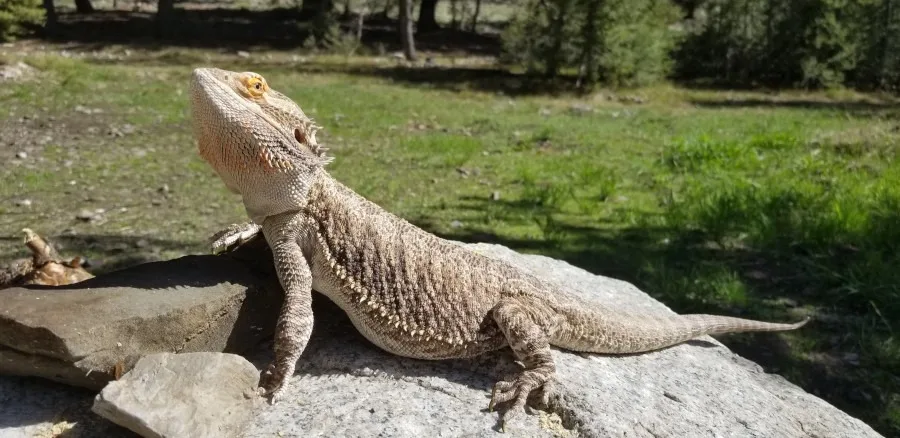
RIP Max. He led the best boondocking life of any beardie!
I hope this article has given you the necessary information to stay safe when boondocking.
As far as we’re concerned, after boondocking for two years, we can genuinely answer the question, “Is boondocking dangerous?”
No, free dispersed camping is safer than campgrounds if you follow the tips listed earlier in this article.
Bottom line, be vigilant and you’ll remain safe.
Armed with this knowledge, I hope you now feel comfortable embarking on your own boondocking adventure (safely)!
Happy camping (boondocking)!
Meet the author.
We appreciate any help in bringing you great content. Donate or buy us a coffee on our Ko-Fi site. Or subscribe to our YouTube Channel.
Thank you so much for being here!
